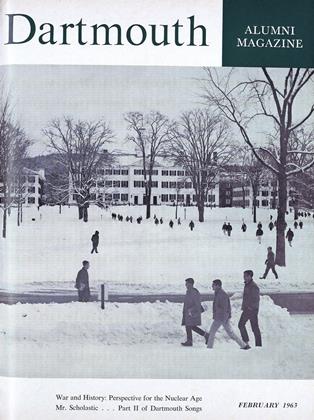Faithful readers of "Civil Engineering" will have found the following references to T.S. alumni in the December 1962 edition. On page 22, under News of Members, is the announcement that Steve Olko '47 has been admitted to practice before the U. S. Patent Office as a patent agent. On page 24, we learn that Hanque Parker '47 is now Professor Parker at Stanford University. According to the notice, Hanque, who has been with the Green-Winston-Drake joint venture on the construction of two of the Trinity River tunnels in Northern California, will teach construction administration to both undergraduate and graduate civil engineering students and engage in research on construction techniques. In the same issue may be found references to the numerous activities of Merit White '31. Merit as Chairman of the Engineering Mechanics Division is co-author of a contribution to 1963 Preview discussing the role of engineering mechanics in the future work of civil engineers. At the ASCE Environmental Engineering Conference to be held in Atlanta, February 25-28, Merit is to be a panel participant on "Engineering in a Blast Environment."
John Fondahl '48, Professor of Civil Engineering at Stanford University, has contributed comments on CPM (Critical Path Method of Scheduling construction projects) published in "The Constructor," December 1962.
Thayer School alumni will be interested to learn about the type course offered last fall as the introductory course in engineering for sophomores. The catalog number of the course is Engineering Science 21 and it was taught by Professors Sid Lees and Ed Sherrard to about 60 sophomores. The course was developed around a term-long design problem devised to give the students real experience in engineering design. The problem selected was the design of a suitable energy-storing device so that energy generated by a bicycle going downhill might be saved for use when going back up hill.
The design was to be based upon the scientific and mathematical background that the students had acquired in one year of college mathematics and physics. The class of students was divided into four competing companies and each student was required to submit progress reports each week with a final report at the end of the term as a consolidated company report incorporating the final design. The students themselves set their own objectives and goals for the bicycle design. To do this, they conducted a market survey in Hanover to ascertain the potential market for such a bicycle and the optimum amount of money people might be willing to pay for such a device. One of the more difficult technical problems was determining the amount of power a human being could generate and this problem was attacked in a variety of ways including the simple expedient of walking up and down hills in the vicinity of the Thayer School. The lectures for this course were devised to supplement the laboratory and research work by being devoted to specialized topics relevant to the problem. For example, outside lecturers were brought in to lecture on legal problems, market surveys, motors and generators, computer aided design, and the physiology of human muscles.
At the end of the course, the individual companies held a day-long competition presenting their designs and defending their positions. The winning company constructed a working model which enabled them to find out the limitations of an energy-storage bicycle. This company included the following members of the class of '65: David Beattie, Gerald D'Aquin, Jonathan Greene, Selden Hannah, Steven Hudak, Bruce Jolly, Edward Keible, Robert Lichtenwalter, Tom Morton, Arthur Rainey, Paul Sowa, and Harvey Welker. The faculty was quite pleased with the manner in which the course has developed and it is believed that through this experience the students have acquired a new enthusiasm for engineering.
Strasenburgh Hall, the new Medical School dormitory, which was occupied at theopening of the winter term and was formally dedicated on January 19.
 View Full Issue
View Full Issue
More From This Issue
-
 Feature
FeatureDARTMOUTH SONGS
February 1963 By HAROLD F. BRAMAN '21 -
 Feature
FeatureAND MANY DARTMOUTH YESTERDAYS
February 1963 By Edward Connery Lathem '51 -
 Feature
FeatureWAR AND HISTORY
February 1963 By LOUIS MORTON -
 Feature
FeatureMR. SCHOLASTIC
February 1963 By CLIFF JORDAN '45 -
 Class Notes
Class Notes1931
February 1963 By WILLARD C. "SHEP" WOLFF, JOHN K. BENSON -
 Class Notes
Class Notes1935
February 1963 By WM. W. FITZHUGH JR., DAVID D. WILLIAMS












